Beginners often wonder if there is an easier way to play the F major chord on baritone ukulele. Here are all the options.
Probably the easiest option is to use the moveable C shape on the 5th fret. That said, the first-fret F shape is extremely useful in many ways, as we’ll discuss below. So don’t give up on it, just keep at it.
Choose from the options below based on the chords that come before or after your F chord.
As beginners, we think of chords individually—how to play a F major, how to play an A minor, and so on. But over time, we learn to think of chords in groups that fit together in patterns that appear again and again in songs. Different ways of playing the same chord allow us to play these common patterns, called chord progressions, more easily.
More ways of playing a particular chord also help you to:
- make faster chord changes (see all my tricks for faster chord changes in this article).
- control the high note to form a melody, called chord melody or chord soloing.
- control the low note (the bass note), which gives the chord a slightlly different flavor and lets you make interesting bass lines with the low notes.
In this article we cover five different ways to play an F major chord. At the end, I’ve included an Appendix for Theory Nerds, to show where an F major chord appears in the keys that you’ll typically be using on baritone uke.
If you need to review the five basic major chord shapes in their open and moveable shapes, check out this article with lots of full-color diagrams.
Color key:
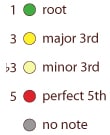
F Major – Option 1

Option 1 is the basic first-fret position for F major on baritone ukulele.
Here are several fingering options. Choose the fingering that works best with the chords that come before and after the F chord:
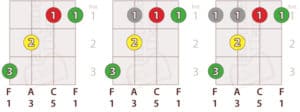
Beginners often find this shape to be a bit difficult. The best advice I can give you is don’t avoid it, and give yourself permission to not be perfect. Over time, your fretting hand will develop muscle memory. The shape will become easier, the sound more precise, and eventually it’ll be second nature.
Meanwhile keep using it, and embrace being a work in progress. It’s an important and very useful shape for several reasons:
- it’s moveable (as is any chord shape when all four strings are fretted at once).
- at its most fundamental, the F shape is actually the moveable E shape. If you move the F shape back toward the nut by one fret, to the “zero” fret, you’ll be playing E major with two open strings. This fact is useful to understand so you can use the CAGED method for playing chords across the neck.
- this shape is the position for playing a root position major chord on baritone ukulele, i.e. 1-3-5-8. When you use this shape on the first fret, you get the note F on the bottom of an F major chord, in root position.
- as you move the shape across the neck, you can play some of the most common chords you’ll need in many songs.
Use this shape across the fretboard to get different chords, like this:
zero fret – E major
1st fret – F major
2nd fret – F# major
3rd fret – G major
5th – A major
6th – Bb major
7th – B major
8th – C major
– and so on, up the neck.
Regardless of where you use this shape, you’ll always have the root note on the bottom, and the chord voicing will always be 1-3-5-8.
Here is the music notation for the 1st-fret F shape:
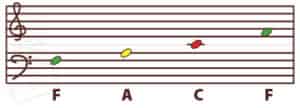
F Major – Option 2

Option 2: On the 3rd fret, use the moveable D shape to make an F major chord.
Although this shape is diificult to fret, I recommend being aware of it and how it fits into the sequence with the other shapes. Most players will skip this option and choose option 1 or option 3 instead. However, knowing about it helps you remember which shapes come before and after. I’ve explained the sequence in more detail below.
Meanwhile, notice how each shape begins where the previous shape ended.
Here’s the music notation for option 2:
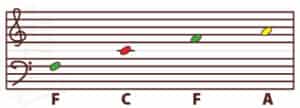
Beginner Tip: You can use these same five chord shapes to play all the major chords across the baritone ukulele fretboard. Commit to mastering these five shapes!
F Major – Option 3
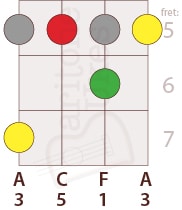
Option 3: On the 5th fret, use the moveable C shape for another way to play an F major chord.
Use this shape to switch easily between F major and D minor, a move that happens often with songs in the key of C (the ii chord and the IV chord) and songs in the key of F (the I chord to the vi chord).
Here’s what option 3 looks like in music notation:

Intermediate Tip: Once you’ve learned the five major chord shapes, you can learn the CAGED sequence and the notes of the fretboard, and you’ll soon be moving freely all over the neck.
F Major – Option 4

Option 4: On the 8th fret, use the moveable A shape to play an F major chord.
You might use this option when chord soloing, when you want to use a high C or high D on top.
Here is option 4 in notation:
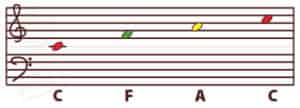
Intermediate Tip: Learning where the root note (shown as a green dot) is located in each chord shape is very helpful when combined with learning the notes on the fretboard.
F Major – Option 5
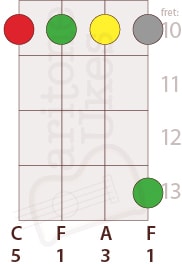
Option 5: On the 10th fret, use the moveable G shape to play an F major chord.
Learning these shapes higher up on the neck is really helpful for chord soloing and learning to play riffs and runs.
Here is what option 5 looks like in music notation:
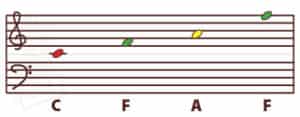
Here is a fun chord progression you can try on the 10th fret, without moving your hand and forefinger at all:
This progression works on any fret. For example, try it on the 5th fret to play: C major to Cmaj7 to C7 to F major.
How to remember the order of the chord shapes as you move across the neck
Let’s review the options above. To play an F major chord, use these shapes:
- moveable E shape – 1st fret
- moveable D shape – 3rd fret
- moveable C shape – 5th fret
- moveable A shape – 8th fret
- moveable G shape – 10th fret
You can easily remember the order in which to use these shapes with the word CAGED. To play F major chords across the neck, start with the moveable E shape at the 1st fret. Then proceed up the neck with the other shapes in the order of the word CAGED. So you would get E-D-C-A-G. The sequence repeats starting on the 13th fret.
This order works for every major chord. For example, to play C major chords across the neck, start with the C shape on the “zero” fret, then continue the sequence of shapes in the order of the word CAGED, so you would get C-A-G-E-D.
This is called the CAGED method.
For more options for playing chords across the neck, check out my article about the CAGED method for baritone ukulele. I spent weeks on those illustrations. Hope you find them helpful!
Appendix for Theory Nerds
This chart shows you where an F major triad occurs, in terms of scale degree, in the six easiest keys for baritone ukulele.
I recommend focusing on the easiest keys for baritone uke, and using a capo if you absolutely must play in other keys.
Some ukulele and guitar teachers recommend focusing on just two keys, C major and G major. I think that’s a great idea, for starters. But for baritone ukulele, I also recommend working with the key of D, because D is the lowest note on your bari uke.
Learning those three keys, and how to use a capo, will allow you play almost popular any song. But, at the most, I would stick to the six easiest keys for baritone ukulele.
Getting back to our F major triad chord and the 5 options shown above, any particular major chord functions as a different scale degree in different keys. Like this:
F
F
F
F
F
Factoid: F major is the V chord in the key of B flat.

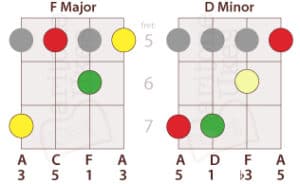



0 Comments